
Concept explainers
(a)
Interpretation:
The bonding and anti-bonding combinations
Concept introduction:
The linear combination of atomic orbital (LCAO) states that two atomic orbitals combine together to form a new orbital which is known as bonding molecular orbital.
The molecular orbital theory also states that two atoms combines together to form a molecule. During the formation of a molecule, the electrons are shared between two atoms to form a
Answer to Problem 1.47AP
The bonding and anti-bonding combinations
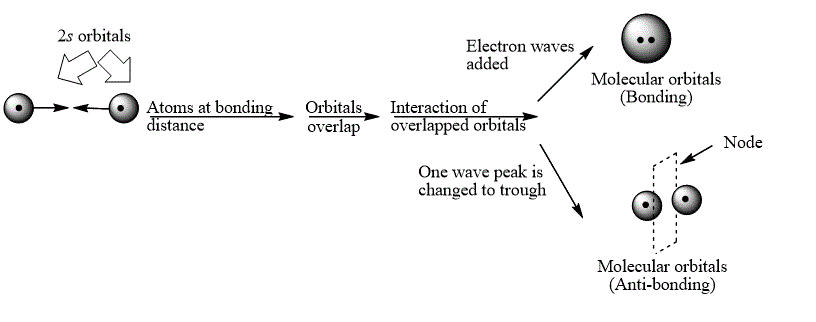
Explanation of Solution
The bond electrons which on addition form a molecular orbital are known as bonding electrons.
The bond electrons which on subtraction form a molecular orbital are known as anti-bonding electrons.
The bonding and anti-bonding combinations for the interaction of two

Figure 1
The bonding and anti-bonding molecular orbital are obtained by the overlapping of two
The bonding and anti-bonding combinations
(b)
Interpretation:
The bonding and anti-bonding combinations
Concept introduction:
The linear combination of atomic orbital (LCAO) states that two atomic orbitals combine together to form a new orbital which is known as bonding molecular orbital.
The molecular orbital theory also states that two atoms combines together to form a molecule. During the formation of a molecule, the electrons are shared between two atoms to form a chemical bond.
Answer to Problem 1.47AP
The bonding and anti-bonding combinations

Explanation of Solution
The bond electrons which on addition form a molecular orbital are known as bonding electrons.
The bond electrons which on subtraction form a molecular orbital are known as anti-bonding electrons.
The bonding and anti-bonding combinations for the interaction of two
 Figure 2
Figure 2
The bonding and anti-bonding molecular orbital are obtained by the overlapping of two
The bonding and anti-bonding combinations
(c)
Interpretation:
The bonding and anti-bonding combinations
Concept introduction:
The linear combination of atomic orbital (LCAO) states that two atomic orbitals combine together to form a new orbital which is known as bonding molecular orbital.
The molecular orbital theory also states that two atoms combines together to form a molecule. During the formation of a molecule, the electrons are shared between two atoms to form a chemical bond.
Answer to Problem 1.47AP
The bonding and anti-bonding combinations
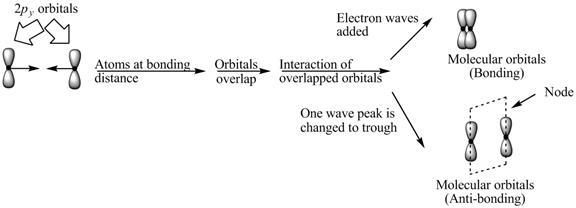
Explanation of Solution
The bond electrons which on addition form a molecular orbital are known as bonding electrons.
The bond electrons which on subtraction form a molecular orbital are known as anti-bonding electrons.
The bonding and anti-bonding combinations for the interaction of two
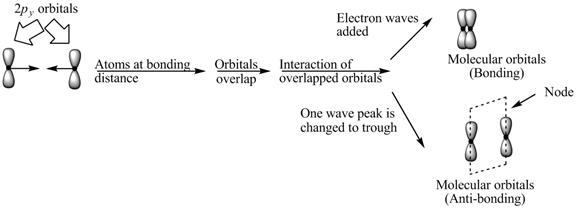
Figure 3
The bonding and anti-bonding molecular orbital are obtained by the overlapping of two
The bonding and anti-bonding combinations
(d)
Interpretation:
The bonding and anti-bonding combinations
Concept introduction:
The linear combination of atomic orbital (LCAO) states that two atomic orbitals combine together to form a new orbital which is known as bonding molecular orbital.
The molecular orbital theory also states that two atoms combines together to form a molecule. During the formation of a molecule, the electrons are shared between two atoms to form a chemical bond.
Answer to Problem 1.47AP
The bonding and anti-bonding combinations
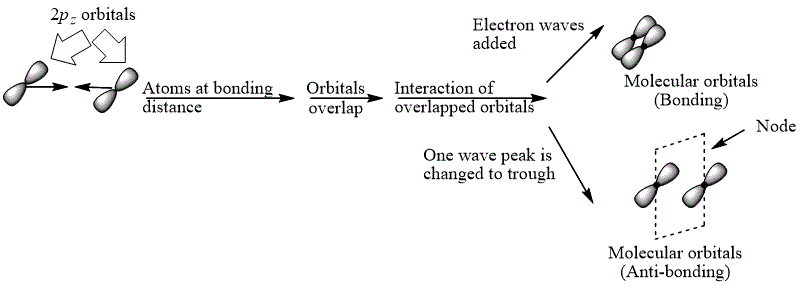
Explanation of Solution
The bond electrons which on addition form a molecular orbital are known as bonding electrons.
The bond electrons which on subtraction form a molecular orbital are known as anti-bonding electrons.
The bonding and anti-bonding combinations for the interaction of two

Figure 4
The bonding and anti-bonding molecular orbital are obtained by the overlapping of two
The bonding and anti-bonding combinations
(e)
Interpretation:
The orbital interaction energy diagram showing the energy levels of the atomic orbitals along with the energies of the given MOs is to be drawn.
Concept introduction:
The linear combination of atomic orbital (LCAO) states that two atomic orbitals combine together to form a new orbital which is known as bonding molecular orbital.
The molecular orbital theory also states that two atoms combines together to form a molecule. During the formation of a molecule, the electrons are shared between two atoms to form a chemical bond.
Answer to Problem 1.47AP
The orbital interaction energy diagram showing the energy levels of the atomic orbitals along with the energies of the given MOs is represented below.
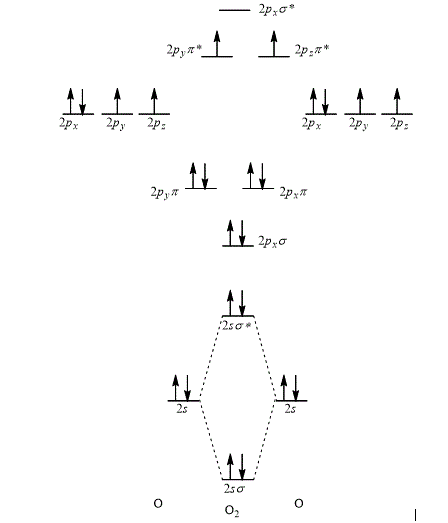
Explanation of Solution
According to the rules for filling the electrons in the molecular orbital, first of all the lower energy molecular orbital is filled followed by the filling of increasing energy order of the molecular orbital.
Thus, the orbital interaction energy diagram showing the energy levels of the atomic orbitals along with the energies of the given MOs of oxygen atom is shown as,

Figure 5
The energy of sigma,
The orbital interaction energy diagram showing the energy level of the atomic orbitals along with the energies of the given MOs is shown Figure 5.
(f)
Interpretation:
The reason corresponding to the fact that liquid
Concept introduction:
The atoms which contain no unpaired electron in their orbital and have total spin equals to zero are known as diamagnetic atoms. The atoms which contain one or more unpaired electron in their orbital are known as paramagnetic atoms.
Answer to Problem 1.47AP
The liquid
Explanation of Solution
In oxygen molecule, two unpaired electrons are present in the anti-bonding molecular orbital. Thus, oxygen molecule is paramagnetic in nature due to which it gets attracted towards the magnetic field.
In comparison to liquid oxygen, the movement of the oxygen gas molecules is faster. Therefore, liquid oxygen molecules are not attracted by the magnetic field.
Hence, liquid
The reason corresponding to the fact that liquid
(g)
Interpretation:
The Lewis structure that best describes the covalent bond(s) in
Concept introduction:
The Lewis structure shows the connectivity between atoms by identifying the lone pairs of electrons in a compound. Lewis structures are also called Lewis dot structures. The valence electrons around an atom are shown by dots. Bonds between atoms are shown by lines and the lone pair of electrons is shown by a pair of dots.
Answer to Problem 1.47AP
The Lewis structure that best describes the covalent bond(s) in
![]()
Explanation of Solution
The given Lewis structures of
The reason corresponding to the fact that liquid
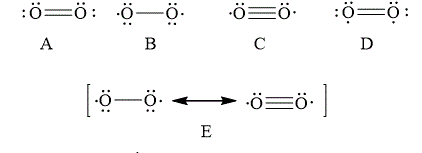
Figure 6
The total number of bonding electrons in
The total number of anti-bonding electrons in
The bond order of
Substitute the number of bonding molecular orbital and anti-bonding molecular orbital electrons in the above expression.
Thus, the bond order of oxygen molecule is
Therefore, the Lewis structures of
In option D, the Lewis structures of
In option A, the Lewis structures of

Figure 7
The Lewis structure that best describes the covalent bond(s) in
Want to see more full solutions like this?
Chapter 1 Solutions
Organic Chemistry, Ebook And Single-course Homework Access
- What are the major products of the following enolate alkylation reaction? Please include a detailed explanation as well as a drawing as to how the reaction proceeds.arrow_forwardA block of zinc has an initial temperature of 94.2 degrees celcius and is immererd in 105 g of water at 21.90 degrees celcius. At thermal equilibrium, the final temperature is 25.20 degrees celcius. What is the mass of the zinc block? Cs(Zn) = 0.390 J/gxdegrees celcius Cs(H2O) = 4.18 J/gx degrees celcusarrow_forwardPotential Energy (kJ) 1. Consider these three reactions as the elementary steps in the mechanism for a chemical reaction. AH = -950 kJ AH = 575 kJ (i) Cl₂ (g) + Pt (s) 2C1 (g) + Pt (s) Ea = 1550 kJ (ii) Cl (g)+ CO (g) + Pt (s) → CICO (g) + Pt (s) (iii) Cl (g) + CICO (g) → Cl₂CO (g) Ea = 2240 kJ Ea = 2350 kJ AH = -825 kJ 2600 2400 2200 2000 1800 1600 1400 1200 1000 a. Draw the potential energy diagram for the reaction. Label the data points for clarity. The potential energy of the reactants is 600 kJ 800 600 400 200 0 -200- -400 -600- -800- Reaction Progressarrow_forward
- Can u help me figure out the reaction mechanisms for these, idk where to even startarrow_forwardHi, I need your help with the drawing, please. I have attached the question along with my lab instructions. Please use the reaction from the lab only, as we are not allowed to use outside sources. Thank you!arrow_forwardHi, I need your help i dont know which one to draw please. I’ve attached the question along with my lab instructions. Please use the reaction from the lab only, as we are not allowed to use outside sources. Thank you!arrow_forward
- 5. Write the formation reaction of the following complex compounds from the following reactants: 6. AgNO₃ + K₂CrO₂ + NH₄OH → 7. HgNO₃ + excess KI → 8. Al(NO₃)₃ + excess NaOH →arrow_forwardIndicate whether the product formed in the reaction exhibits tautomerism. If so, draw the structure of the tautomers. CO₂C2H5 + CH3-NH-NH,arrow_forwardDraw the major product of this reaction N-(cyclohex-1-en-1-yl)-1-(pyrrolidino) reacts with CH2=CHCHO, heat, H3O+arrow_forward
- Draw the starting material that would be needed to make this product through an intramolecular Dieckmann reactionarrow_forwardDraw the major product of this reaction. Nitropropane reacts + pent-3-en-2-one reacts with NaOCH2CH3, CH3CHOHarrow_forwardIndicate whether the product formed in the reaction exhibits tautomerism. If so, draw the structure of the tautomers. OC2H5 + CoHs-NH-NH,arrow_forward
 Chemistry & Chemical ReactivityChemistryISBN:9781337399074Author:John C. Kotz, Paul M. Treichel, John Townsend, David TreichelPublisher:Cengage Learning
Chemistry & Chemical ReactivityChemistryISBN:9781337399074Author:John C. Kotz, Paul M. Treichel, John Townsend, David TreichelPublisher:Cengage Learning Chemistry & Chemical ReactivityChemistryISBN:9781133949640Author:John C. Kotz, Paul M. Treichel, John Townsend, David TreichelPublisher:Cengage Learning
Chemistry & Chemical ReactivityChemistryISBN:9781133949640Author:John C. Kotz, Paul M. Treichel, John Townsend, David TreichelPublisher:Cengage Learning General Chemistry - Standalone book (MindTap Cour...ChemistryISBN:9781305580343Author:Steven D. Gammon, Ebbing, Darrell Ebbing, Steven D., Darrell; Gammon, Darrell Ebbing; Steven D. Gammon, Darrell D.; Gammon, Ebbing; Steven D. Gammon; DarrellPublisher:Cengage Learning
General Chemistry - Standalone book (MindTap Cour...ChemistryISBN:9781305580343Author:Steven D. Gammon, Ebbing, Darrell Ebbing, Steven D., Darrell; Gammon, Darrell Ebbing; Steven D. Gammon, Darrell D.; Gammon, Ebbing; Steven D. Gammon; DarrellPublisher:Cengage Learning Chemistry: Principles and ReactionsChemistryISBN:9781305079373Author:William L. Masterton, Cecile N. HurleyPublisher:Cengage Learning
Chemistry: Principles and ReactionsChemistryISBN:9781305079373Author:William L. Masterton, Cecile N. HurleyPublisher:Cengage Learning Chemistry: Principles and PracticeChemistryISBN:9780534420123Author:Daniel L. Reger, Scott R. Goode, David W. Ball, Edward MercerPublisher:Cengage Learning
Chemistry: Principles and PracticeChemistryISBN:9780534420123Author:Daniel L. Reger, Scott R. Goode, David W. Ball, Edward MercerPublisher:Cengage Learning





